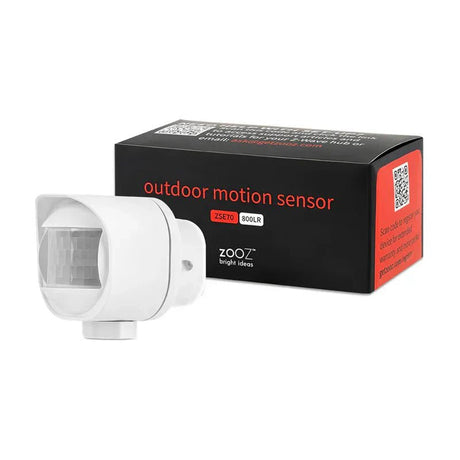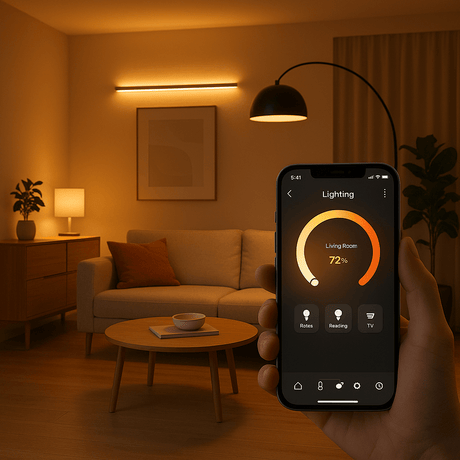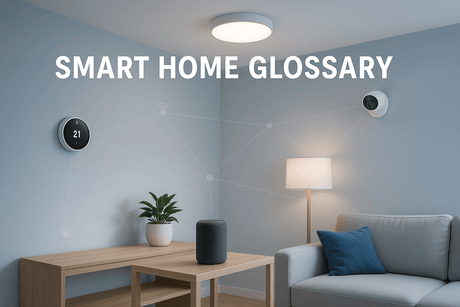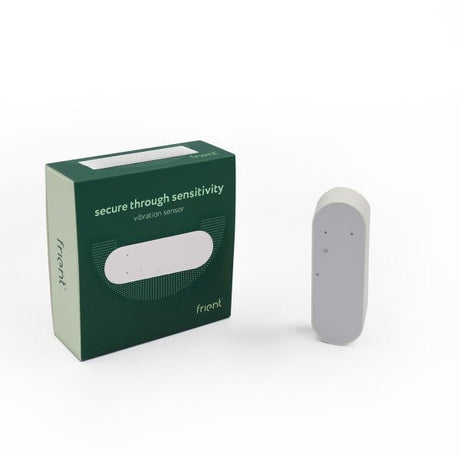One benefit of implementing Smart Home control of your lighting, security and appliances is that those devices can then be operated from an App on your smartphone or tablet, or from a web UI on your PC or laptop.
Of course, it's not always convenient to go hunting for your phone or turn on your PC just to control a light! So that's where Remote Controls & Wall Controllers can really be used to provide quick and easy access to local device control, either individual devices, whole groups of devices at the same time or even complex lighting Scenes where many devices are set to different states, colours and levels of brightness - all at the touch of a single button.
Manufacturers of Z-Wave, Zigbee & WiFi Remote Controls & Wall Controllers usually make them in two different form factors - portable remote control types, for example like a TV remote contro or a keyfob and those that are designed to be mounted on a wall or surface, much like a standard light switch. Because the form factor that you wish to use is usually pretty obvious, it typically means that you only have the choice between manufacturers to contend with, where some will offer more advanced capabilities and others will offer simpler functionality, often at a cheaper price. Remember that you can mix and match manufacturers on the same system as they are all compatible - more information can be found in our Understanding Compatibility guide.
This guide explains what the different types of device are used for and gives extra details to help select between the manufacturers.
There is one other type of remote control that's worth mentioning - Voice Assistants - while these technically aren't remote control "devices" they still offer a convenient way of controlling your Smart Home system as a whole. We'll cover some of the differences between the main Voice Assistant manufacturers in this guide too. In the meantime, if you haven't done so already, be sure to check out our Smart Home - Controllers and Why you Need Need One guide!
Remote Controls & Wall Controllers
Firstly, all devices within this category are battery powered so they can be installed quickly and easily wherever you wish, or even just left sitting on the sofa or coffee table like you would with a remote control for your TV or stereo system!.
Remote Controls - Z-Wave | Zigbee | WiFi
These are usually available in two different types, handheld "candy-bar" shaped like a TV or set-top-box remote control, or in the style of a keyfob like your house alarm or car keys. Some might be designed for both uses, being candy-bar shapped but with a lanyard ring and small enough to fit in your pocket!
Remote Controls - things to think about:
- Power Source - Some devices can be powered from low voltage mains adapters which means you won't have to replace or recharge batteries. Look for devices that allow this if they are going to be in areas that have a convenient power point, especially if the device will be used often.
- Battery Type - Many devices use rechargeable batteries which means you should never need to worry about replacing them. Some use specialist "coin cell" or odd sized batteries, so it's worth factoring battery replacement costs into your decision.
- Number Of Buttons - More buttons might not be better! While a 10 button remote will offer bags of functionality, in reality will you be able to remember what all those buttons do? Consider the aim and what you're trying to achieve, it could be better to choose a device with a single button, but perhaps with different ways to interact with it - single tap, double tap, triple tap, etc. That's much easier to remember - single tap to turn the lights on, double tap to turn them off and triple tap to set them to a predetermined level.
- Portability - Consider a smaller device if you're intending to use it as a keyring or carry it around with you.
- Mesh Network - Since these are typically battery powered devices they do not have the same transmit and receive power as a mains-powered device. This means that you really need a decent Z-Wave or Zigbee mesh network or good WiFi coverage to ensure that they operate well, especially if they are intended to be used in a mobile fashion, moving around your home.
- Optional Secure Associations - In the case of a Z-Wave device, consider choosing one that has the ability to send commands to Associated devices without Security when it itself has been Included with Security. This can be important because a device that is Included with Security will then only send commands using Security. If you're trying to Associate to a device that is Included without Security then the commands will be ignored.
- Information - More information about these issues and other things to consider is available in our Getting Started guide.
Wall Controllers - Z-Wave | Zigbee | WiFi
Wall controllers are typically made to resemble a standard light switch form factor so that they can be used in place of or in addition to your existing light switches. There are some exceptions though which offer some interesting multiple button features as well as some more unique gesture based controls!
Wall Controllers - things to think about:
- Power Source - Some devices can be powered from low voltage mains adapters which means you won't have to replace or recharge batteries. Look for devices that allow this if they are going to be in areas that have a convenient power point, especially if the device will be used often.
- Battery Type - Many devices use rechargeable batteries which means you should never need to worry about replacing them. Some use specialist "coin cell" or odd sized batteries, so it's worth factoring battery replacement costs into your decision.
- Number Of Buttons - More buttons might not be better! While a 10 button remote will offer bags of functionality, in reality will you be able to remember what all those buttons do? Consider the aim and what you're trying to achieve, it could be better to choose a device with a single button, but perhaps with different ways to interact with it - single tap, double tap, triple tap. That's much easier to remember - single tap to turn the lights on, double tap to turn them off and triple tap to set them to a predetermined level.
- Physical Size - If you're wanting something that blends in to your room to be used alongside or in replacement of your existing light switches then choose something that has a standard light switch form factor. Other options won't blend in as easily, but perhaps that's the point if you want something to be the center of attention in a particualr space!.
- Mesh Network - Since these are typically battery powered devices they do not have the same transmit and receive power as a mains-powered device. This means that you really need a decent Z-Wave or Zigbee mesh network or good WiFi coverage to ensure that they operate well, especially if they are intended to be used in a mobile fashion, moving around your home.
- Optional Secure Associations - In the case of a Z-Wave device, consider choosing one that has the ability to send commands to Associated devices without Security when it itself has been Included with Security. This can be important because a device that is Included with Security will then only send commands using Security. If you're trying to Associate to a device that is Included without Security then the commands will be ignored.
- Alternative Devices - Do you really need a "Wall Controller"? Sometimes a module or full replacement light switch can offer similar functionality - for example if you simply need an additional control to set a simple Scene then swapping a single channel relay / switch module to a dual channel version would give you a second switch input. You don't have to connect anything to that channel load-wise, so just use the secondary switch as a Trigger for your Scene in your Smart Home Controller.
- Information - More information about these issues and other things to consider is available in our Getting Started guide.
Voice Assistants
With the stresses of modern life nowadays, we're all likely to benefit from some form of assisted living and there's nothing quite like having your own personal assistant at your beck and call! Whether you're an Alexa fan, a Siri convert or an OK Google addict, a Voice Assistant can be used to interact with your Smart Home like never before. From controlling your lights, adjusting your room temperature, answering your phone calls, checking who's at the front door or triggering entire sequences of events from a single word, Voice control is no longer confined to the movies - now we can all be like Tony Stark and chat with our own version of Jarvis!
Of course, a Voice Assistant is no substitute for a dedicated Smart Home Controller as they tend to have limited functionality when it comes to creating logic for your Smart Home. While they are excellent for showing off your "Let's Party" mood lighting, they will struggle to carry out more complicated scenarios such as "turn the lights on at 6pm, but only if nobody is home and the alarm system is armed in away mode". More information is available in our Smart Home - Controllers and Why you Need Need One guide.
We believe that being able to control your Smart Home by voice should be considered an additional benefit of the overall system, rather than the main focus for it, which is why we decided not to sell Voice Assistants ourselves.
That said, we do recognise that Voice Assistants are a useful form of remote control, so we have included a simple comparison here too.
Voice Assistants - things to think about:
- Which Platform - This typically comes down to what ecosystem you're tied into with regards to your smartphone and tablet use. If you're an Android only user then you won't be able to use Siri. If you're an iOS only user then you can normally choose any of the Voice Assistants. Windows Phone users ..... well maybe it's time to rethink that particular choice!
- Smart Home Controller Support - Make sure your Smart Home Controller is actually supported by your chosen Voice Assistant. It's pointless kitting out your home with HomePod, Apple TV and iPad devices if your Smart Home Controller doesn't offer HomeKit integration!
- Too Many Chefs - If you're a mixed Android / iOS household then that's great because you can mix-and-match your Voice Assistants. HomePod in the living room, Echo in the bedrooms and Google Nest in the kitchen. Or can you? Often Smart Home Controllers are only designed to run ONE integration to a Voice Assistant, adding multiple integrations can create conflicts or increase the load on your hardware.
- Maintenance - Often maintaining a Voice Assistant integration can be time consuming, each time the platform updates it can break device mappings and scene triggers for example. This can be compounded if you have multiple different integrations!
- Use a Bridge - Using a "Bridge" can help with many of these issues. Typically a Bridge will handle the integration with multiple different Voice Assistants independently to your Smart Home Controller and as it's a dedicated device it can be kept updated automatically in line with any changes to the Voice Assistant platforms. The Bridge then communicates directly with your Smart Home Controller using its local API connection, rather than being purely Cloud based or requiring specific protocol support such as HomeKit.
Getting Help and Advice
Hopefully this guide has helped clarify what options are available, what the different Z-Wave, Zigbee & WiFi Remote Controls & Wall Controllers do, and shown the comparison between manufacturers. If you need any further help or advice, contact Vesternet and we will do our best to answer all your questions.


















